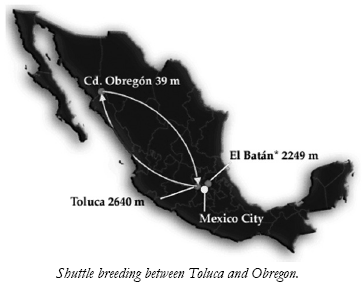|
Second Innovation: Shuttle Breeding
Borlaug’s second breeding innovation had the initial
objective of speeding the process by growing two
successive plantings per year—one during summer in the
low-soil-fertility, rainfed areas at Chapingo and
Toluca, in high altitudes not far from Mexico City, and
another during the winter season almost two thousand
kilometers to the north, in the irrigated area near sea
level in the Yaqui Valley in Sonora, where growing
conditions and soil fertility were much more favorable.
 Ever
since his trip to Sonora he had been mulling over an
idea he wanted to put to the test. He had brought back
some wheat from the farms in the Yaqui Valley, and now,
in May of 1946, he wanted to prepare a plot to plant it.
If it grew well in the highlands of Chapingo or Toluca
during the summer, he would gather the seed in the fall,
take it north again, and plant it in the Yaqui. (Because
of the difference in altitude and temperature, the
Toluca and Yaqui planting seasons were at different
times of the year.) The following spring the next
generation would be harvested in the Yaqui and would be
put into the soil at Toluca, and so on back and forth.
It would mean that he could grow two generations a year
instead of one, cutting his breeding time by half. Ever
since his trip to Sonora he had been mulling over an
idea he wanted to put to the test. He had brought back
some wheat from the farms in the Yaqui Valley, and now,
in May of 1946, he wanted to prepare a plot to plant it.
If it grew well in the highlands of Chapingo or Toluca
during the summer, he would gather the seed in the fall,
take it north again, and plant it in the Yaqui. (Because
of the difference in altitude and temperature, the
Toluca and Yaqui planting seasons were at different
times of the year.) The following spring the next
generation would be harvested in the Yaqui and would be
put into the soil at Toluca, and so on back and forth.
It would mean that he could grow two generations a year
instead of one, cutting his breeding time by half.
It had
not been tried before: two generations each year instead
of one, plus a complete switch from one latitude and
altitude to another. This concept flew in the face of
traditional plant breeding methods, a dogma that
precluded two generations per year. But Borlaug saw no
genetic reason why he couldn’t grow and select two
generations each year. He would try it.
The
shuttle-breeding process yielded a double bonus. First,
as Norm had predicted, they were able to advance the
generations twice as fast. The second result, even more
important, was fortuitous. As the segregating
populations were shuttled back and forth over ten
degrees of latitude and from near sea level at the Yaqui
Valley in Sonora to over eight thousand feet of altitude
at Toluca, they were exposed to different diseases,
different soils, different climates and different
day-lengths: shortening from the time of planting in
winter in Sonora and lengthening in summer in Toluca.
The result was much more than simply a speeding of the
breeding process. The plants that survived and performed
well at both locations were now well adapted to a wide
range of conditions.
Norm
said, “The Princess of Serendip had smiled on our
unorthodox shuttle-breeding effort.” It soon became
apparent that these new early-maturing, rust-resistant
varieties were broadly adapted to many latitudes and
elevations in Mexico. Shuttle breeding subsequently
gained credence worldwide as a method that reduced by
half the years required to breed a new variety as well
as for rapidly achieving wide adaptability to a range of
variables.
Borlaug
says, “Through the use of this technique, we developed
high-yielding, day-length-insensitive varieties with a
wide range of ecologic adoption and a broad spectrum of
disease resistance—a new combination of uniquely
valuable characters in wheat varieties.”
These
characters were valuable in increasing wheat production
in Mexico and neighboring countries, including parts of
the USA, but were to prove even more valuable a decade
later when the widely adapted dwarf Mexican varieties
were successfully introduced into Pakistan, India,
Turkey, Egypt, Iran and China. Without this combination
of characters, the successful transplantation of the
Mexican varieties into other countries would have been
impossible. And the Green Revolution might never have
happened.
|